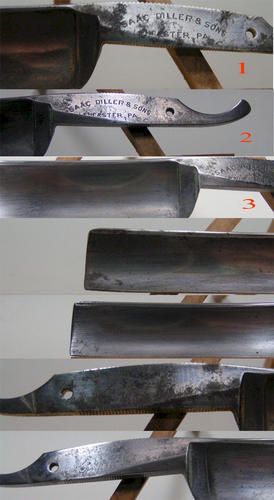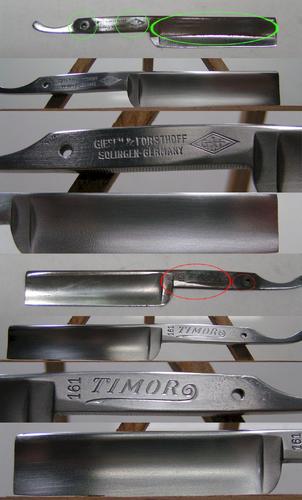Results 71 to 74 of 74
Thread: electrolysis for rusty razor
-
10-10-2012, 03:42 PM #71

I too have been pursuing the "black rust" issue, which is primarily magnetite. It has the same chemical composition as the red rust, but the iron/oxygen ration is different. Also, the black rust is highly magnetic, per its name.
As I've continued to work on the Graef & Schmidt Henckels razor I've tried a couple of new/different set-ups.
I did get a "plain" steel tube from the Home Depot and cut it into six inch sections. I put the sections at 90 degree reference points. Each tube is approximately 2.5 inches from the center of the square they form. I'll put up a couple of photos at home tonight.
In addition, since the negative clip is not attracting anything, I've done away with fancy wiring. Per WhiteLion's setup with the copper J-hooks, I too have decided to hold the blade horizontal. This provides me with two benefits. The first is that I can generally decrease cathode to anode distance without rebuilding my tank. The second is that I can use the alligator clip on my battery charger and connect directly to the spine of the razor. Then I just lower the clip directly into the tank with the razor. After eight hours in the bath, there is no ill effect to the alligator clip or my battery charger.
This does not apply to the positive side. Please DO NOT put your positive terminal into the ionic solution. It will be eaten.
I wanted to put up a couple of photos regarding success:
There is still some black rust present, but it has decreased SIGNIFICANTLY. I expect with a little more time (tonight) it will be removed entirely. As I have used this same blade throughout the entire process, you can reference previous photos, especially post #52 in this thread, if you want to see the progress. I would also like to note, when I pull the razor from the solution, it gets a two minute scrub down with a small brass bristle welding brush and then a wipe dry with a rag. I also used some 00 steel wool to remove the really bad copper plating. Other than the steel wool and the welding brush, probably totaling about eight minutes, I have done nothing to this razor but cook it.
More photos tonight.Do to budget cuts the light at the end of the tunnel has been turned off; we apologize for any inconvenience.
-
10-11-2012, 01:04 AM #72

falingore (BTW is that a sir name or does it have some other meaning? Just curious, that's all). Thank you for sticking with this project and putting in so much time and effort. Your reports are thorough, insightful and extremely helpful, at least to me. I too continue daily on the quest for removal of black rust. I congratulate you on your success thus far.
Here are some observations I have made. First, why do some blades seem to react so dramatically and suddenly to the process and others seem to take for ever to eek out pore by pore any results? My observations show that thinner, narrower blades seem to process rather quickly (less than a day). But the bigger and heavier the blade, the longer the process takes (days).
At present, I am experimenting with different anodes and electrolytes. Varying the power supply, both voltage and amperage, seems to have little effect on the time for processing a blade. I am trying stainless steel but with little effect given my present electrolytes. I know I posted a caveat regarding SS as an anode. I am not suggesting or recommending anyone else test or try it. I am the Tinker so that is what I do, I tinker. But I do it very, very safely. I have conducted additional research on the subject and have taken appropriate steps to protect not only myself, but the environment.
I know for a fact that electrolysis WILL remove black rust. But until I can document a method and procedure for doing it consistently and timely, I will not have reached my objective. As I said before, the chase has just begun. No matter how much better a blade may look from its original condition, if black rust remains, there is still further research to be done.
Randy“Tell me and I forget. Teach me and I remember. Involve me and I learn.” Ben Franklin
-
10-22-2012, 02:34 PM #73
 Interim Conclusions
Interim Conclusions
I have not been neglecting my research on the topic of this thread. In fact, I have been working day and night (well at least the electrolysis has been working through the night while I slept) for the past two weeks. I have been tinkering with this and that: voltage, amperage, distant between electrode and anode, small containers, large containers, surrounded cathode, only one side of cathode facing the anode, different anode materials and different electrolytes. So far, I have found no smoking guns that give a clue to one way being better than another. I tried stainless steel and found it no more effective than regular steel. I have ruled out copper and brass as an anode because they corrode far too quickly. There is a direct relationship between the sizes of the anode, the distance between the anode and cathode and the voltage and amperage that will result. I have also found salt is a good electrolyte but corrodes even stainless steel extremely fast. I will not be using that again. The other two electrolytes I have been using are baking soda and homemade washing soda. The washing soda did not give any better results than the baking soda, maybe because it was homemade. I still want to try washing soda and will purchase some commercial product soon. There are one or two other electrolytes I want to try as well.
Here is the latest test razor I have been using to conduct my research. It is only one of several but I had posted earlier that it was my new bellwether for judging this process. You may or may not be able to see that there was in fact an appreciable diminution in the black rust.
So what are my conclusions at this time? First, let me define my use of “professional” and “non-professional”. Anyone who has restored at least five razors using a buffing wheel falls into the category of professional (for lack of a better word). All others, and especially those who have to hand sand the blades, are non-professional.
1. Does electrolysis remove rust? The answer is an emphatic YES!!! Brown rust seems to be removed in short order from 15 minutes to a couple of hours. Black rust though takes considerable time, measuring by days, not hours.
2. Is this a tool for the professional restorer’s workshop? The answer is, at present, NO. This process is not going to be of much value to them. They can use other tools at their disposal to achieve better results in less time. This process, for them, is not ready for prime time. The only circumstance in which I can see a professional using this is if there is black rust imbedded in etching that would not withstand buffing or sanding.
3. Is this a tool for the non-professional’s workshop? For the person who is not a professional and is working with limited equipment, this is definitely a valuable asset. I have documented in this thread blades that cleaned up exceptionally well in as little as 15 minutes to an hour. For deep pitted blades, you will never remove the pits with this process, but you can make the blade hygienic and with some labor, diminish the appearance of the pits and still have a nice shaving razor. This whole thing costs nothing if you have a car charger, a plastic bucket, some medal for the anode and some baking soda. Besides razor blades, it is great for cleaning your tools or any other rusted items. Not bad for something so very simple.
I have not given up on my experiments. I just wanted to report where I am at present. I need to find a better electrolyte! That is the direction I am headed in next.
By the way: I posted a Timor blade earlier in this thread which I reported I had removed all of the black rust but not the pitting, of course. Just thought you might like to see the results after some effort to get the blade in a better condition.
I will report more if anything changes.
RandyLast edited by WhiteLion; 10-22-2012 at 03:03 PM. Reason: Manage pictures
“Tell me and I forget. Teach me and I remember. Involve me and I learn.” Ben Franklin
-
-
10-22-2012, 05:21 PM #74

I have read this article at one sitting and enjoyed the well presented and logged experiments!
As for copper plating:
I have used cider vinegar as a cleaner de-rusting solution with no electrical connections. I was using copper wire to hold the blade in the solution.
After a few blades, All of a sudden I got a flash plating of copper on succeeding blades.
So, in my opinion, the plating can be as much a function of the Ph of the solution as of the current flow. With enough copper ions in the solution, there will be a plating effect. I would also think that the acid solution with steel and copper in it made a simple electrical cell/battery that caused the ion flow to occur. Seems I read somewhere or saw in basic science that a nail and a copper wire stuck into an apple would give an electrical potential between them. Faraday??
As far as using the Electrolysis, I won't, howsomever, I heartily enjoy the possibilities of the process!
Thanks to all that contributed to the increase in knowledge! A big "Thumbs Up" to you all!
~Richard


 59Likes
59Likes LinkBack URL
LinkBack URL About LinkBacks
About LinkBacks








 Reply With Quote
Reply With Quote




